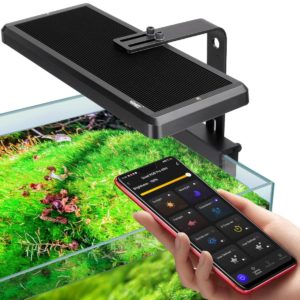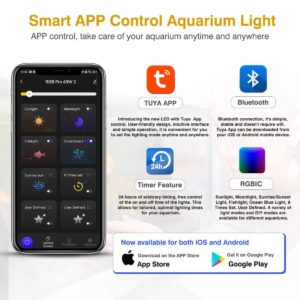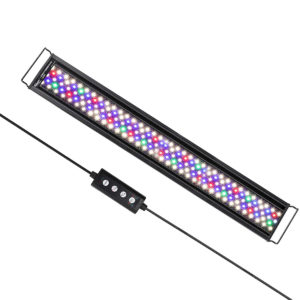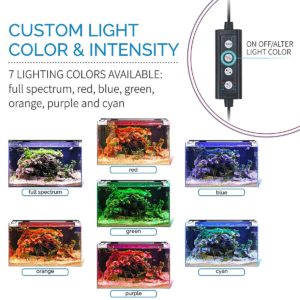Aquarium Lighting Basics Part Three
-Lighting Requirements for Planted Aquarium
For the photosynthesis of aquatic plants, plant growth lights are a great tool with numerous benefits, like enhancing the color and growth of plants. However, too much light will cause algae to thrive in your tank. So, how about the light requirement for a planted aquarium? Generally, the lighting requirements vary from high light, medium light, and low light plants. In today’s article, we will talk more about that.
Content Table
Will LED lights grow plants in an aquarium
Will LED lights grow plants in an aquarium or let’s put it another way, are there the best aquarium-led lighting? Yes, as long as there is a right light spectrum. There are a plethora of benefits to adding an LED light to your planted tank.
A LED light is an energy-efficient lamp, which mimics the sunlight and glows in various light colors. White light color is helpful to promote the photosynthesis of plants, while it also enhances the colors of plants. Red, green, and blue light color is necessary for freshwater aquatic plants. And then, plants will release oxygen into the water, which will improve the oxygen level in the tank. Besides that, ultraviolet LED lights are beneficial to sterilize, especially in reducing the bacteria infection risk of fish disease. Additionally, the vivid light improves the ornamental value of your planted tank.
By the way, what should you consider when finding the best aquarium-led lighting for your tank? In general, the following factors should be taken into account, including the tank size (width and depth), light coverage area, 24/7 light spectrum and timer, types of aquatic plants, and others. Take a 30-gallon planted tank as an example. Provided that the 30-gallon tank is about 36 inches in length, 26 inches in width, and 16 inches in height. Then, the length of your LED light should be 36 inches at least.
Besides, if you keep Hornwort and Moneywort in the tank, you should keep the light on for about 10–12 hours. Also, Hornwort and Moneywort are mediums to highlight plants. Accordingly, the ideal light intensity should be 20–40 lumens per liter.
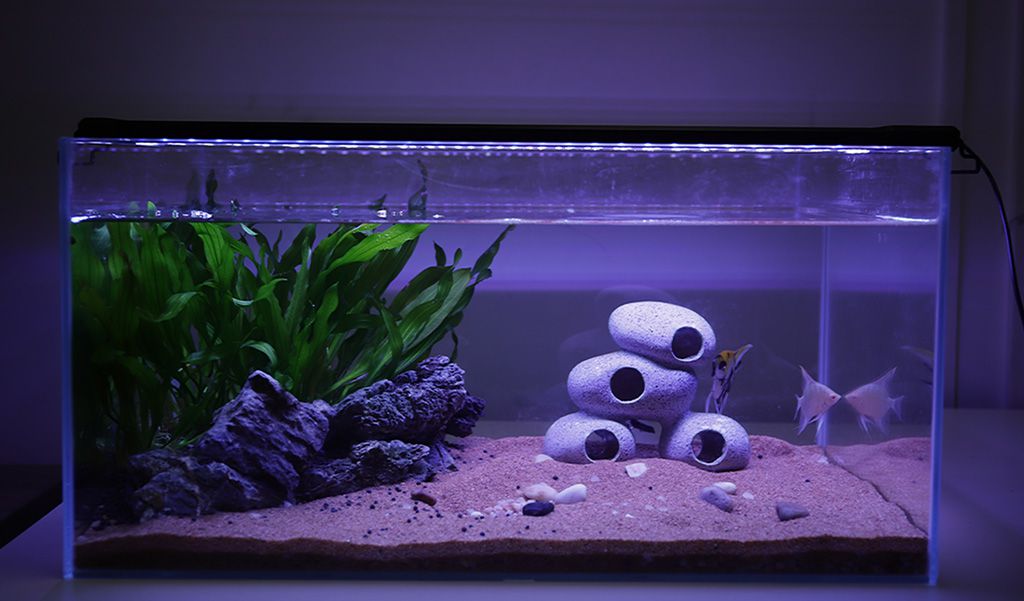
Lighting requirements for planted aquarium
When it comes to the light requirement for planted aquariums, the lighting hours, light intensity, PAR values, wavelength, or others should be taken into consideration.
- Lighting hours: It means the time you keep the aquarium light on.
- Light intensity: It refers to the brightness of the aquarium light.
- PAR values: It measures the amount of light for photosynthesis.
- Wavelength: the distance of two points on a wave of energy. Generally, plants photosynthesize through visible light, ranging from 380 nm to 750 nm. However, the available PAR of plants focuses on 400-700 nm.
Next, we will cover the common lighting requirements for different types of aquatic plants. The table below is a division for common plants and does not represent the needs of all aquatic plants.
| Types of aquatic plants | Lighting hours | Light intensity | PAR values |
| Low light plants | 8–10 hours | 10-20 lumens/liter | 10-50 μmol/s |
| Medium-light plants | 10 hours | 20-40 lumens/liter | 50-120 μmol/s |
| High light plants | 10–12 hours | More than 40 lumens/liter | 120-200 μmol/s (or higher) |
Is blue light bad for aquarium plants
Blue light is not damaging to aquarium plants. On the contrary, it is suitable and essential for many plants’ growth. Blue light can be absorbed by chlorophyll, which makes sense in the photosynthesis of aquatic plants. Specifically, blue light affects aquarium plants. Commonly, the low to medium intensity of blue light is enough for photosynthesis. Because blue light is high-intensity light. Consequently, the plants grown under blue light are prone to be shorter and have thicker leaves. Hence, blue light can be used as supplementary light color. Besides that, the color of plants’ leaves will be darker under the blue light. Moreover, blue light makes the plants’ stems healthier.
By the way, a bluetooth LED light is an excellent plant grow light for plants that need more blue light. For instance, stem plants and some carpeting plants. With the free dimming of RGB three primary colors, there are 300+ colors for you to choose from. Also, the brightness and color temperature can be adjusted. Accordingly, the light gives bright light effects and a different vision for your planted tank.
Which type of lighting is important for aquarium plants growing
In this part, we will take freshwater aquatic plants as an example and take a look at the important lighting type for aquarium plants growing.
Ideal light spectrum
- The wavelength range of 630-700 nm: at least 50 percent of red light
- The wavelength range of 500-580 nm: at least 35 percent of green light
- Its wavelength range of 435-495 nm: less than 15 percent of blue light
Light colors
- Red light: It is helpful to promote the production of chlorophyll, which is vital for photosynthesis and plant growth.
- Greenlight: It maximizes plants’ exposure to light and makes sense for plant growth.
- Blue light: It makes the colors of plants’ leaves darker. Also, it is good for stem growth.
Additionally, we will list some examples here. As for stem or carpeting plants, an LED light with a lot of blue light may be the best aquarium-led lighting. On the other side, low-light plants, like Anubias and Java fern, may need more red light.
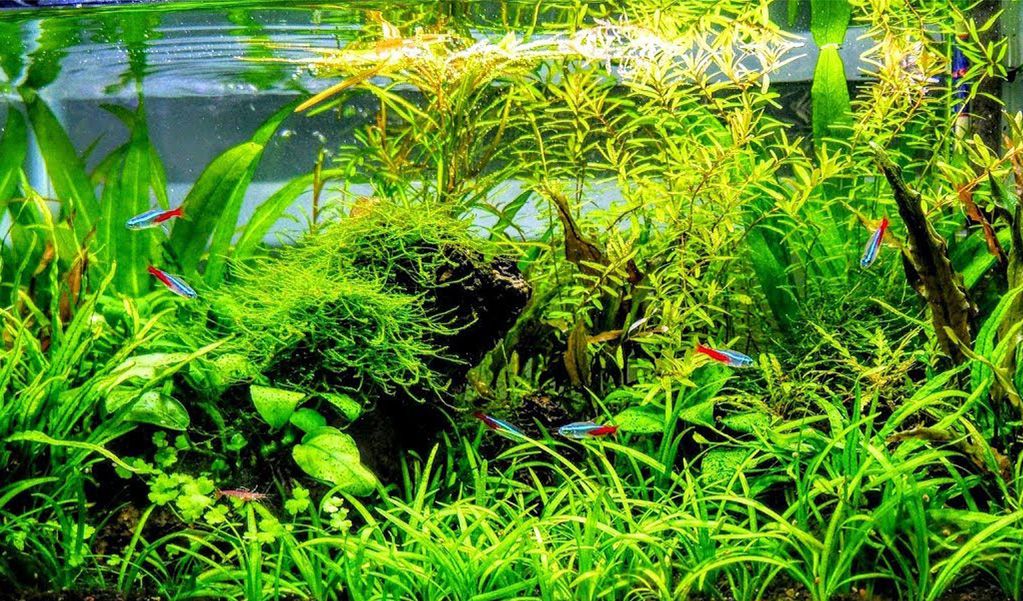
How many plants can grow with a 72w LED light?
Take a 72W LED light as an example, it can be used in 48-55 inches tanks. The light is ideal for various types of planted aquariums with different light requirements. There are ten levels of brightness and seven colors for the light setting. The multiple brightness changes can promote photosynthesis. Consequently, the plants can get better living conditions. Besides that, there are four available programming modes, including the Default mode, DIY mode, Gradient mode, and All-day all-optical mode. The 4 light modes are very infinitely for what this light can do. You can use the 72W LED light in a fully planted tank 55 inches.
By the way, if you are confused about the light setting, you can know more in the article – How to Set a Light Timer with Hygger 957 Programmable Light.
Reminder
In a nutshell, a full spectrum of light is best for aquatic plants. Also, just set the light according to the aquatic plants in your tank. Just keep in mind, that it’s important that get prior knowledge of the plants’ lighting requirements before adding the plants to your aquarium.
Related topics:
That’s all for today. For additional information about aquarium lighting, just stay tuned for the article – Aquarium Lighting Basics Part Four – Lighting Requirements of Tropical Fish, which will mainly focus on the light requirements of diverse fish. Finally, thank you for your time, and we hope this article helps.

